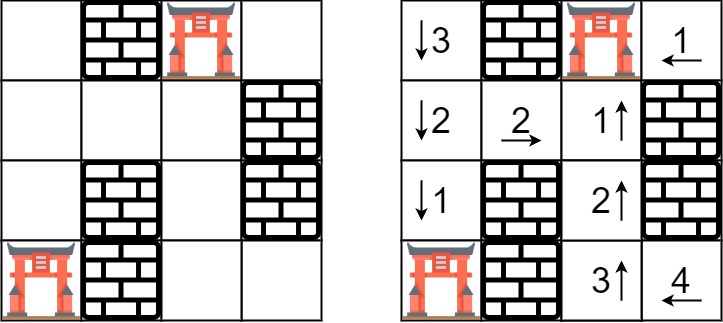[LeetCode] 286. Walls and Gates
You are given an m x n grid rooms initialized with these three possible values.
-1A wall or an obstacle.0A gate.INFInfinity means an empty room. We use the value231 - 1 = 2147483647to representINFas you may assume that the distance to a gate is less than2147483647.
Fill each empty room with the distance to its nearest gate. If it is impossible to reach a gate, it should be filled with INF.
Example 1:

Input: rooms = [[2147483647,-1,0,2147483647],[2147483647,2147483647,2147483647,-1],[2147483647,-1,2147483647,-1],[0,-1,2147483647,2147483647]] Output: [[3,-1,0,1],[2,2,1,-1],[1,-1,2,-1],[0,-1,3,4]]
Example 2:
Input: rooms = [[-1]] Output: [[-1]]
Constraints:
m == rooms.lengthn == rooms[i].length1 <= m, n <= 250rooms[i][j]is-1,0, or231 - 1.
墙与门。
你被给定一个 m × n 的二维网格 rooms ,网格中有以下三种可能的初始化值:
-1 表示墙或是障碍物
0 表示一扇门
INF 无限表示一个空的房间。然后,我们用 231 - 1 = 2147483647 代表 INF。你可以认为通往门的距离总是小于 2147483647 的。
你要给每个空房间位上填上该房间到 最近门的距离 ,如果无法到达门,则填 INF 即可。来源:力扣(LeetCode)
链接:https://leetcode.cn/problems/walls-and-gates
著作权归领扣网络所有。商业转载请联系官方授权,非商业转载请注明出处。
题意是给一个二维矩阵,里面的 -1 代表墙,0 代表门,INF 代表一个空的房间。请改写所有的 INF,表明每个 INF 到最近的门的距离。
这一题是带障碍物的 flood fill类 的题目,既然是问最短距离,所以这个题目应该还是偏 BFS 做。还有一题思路比较接近的是542题,也是在矩阵内通过已知的一些距离去累加起来找未知坐标的距离。还有一道题也比较类似,也是带障碍物的 flood fill 类型的题目,1730题。
具体思路是我们从矩阵中的门出发,也就是先找到矩阵中的 0,把这些 0 的坐标放入 queue。从 queue 中弹出这些 0 的时候,往四个方向扫描,看看这些 0 的周围是否有 INF。如果有,则这些 INF 就有一个具体的距离了,把这些有了距离的 INF 再放入 queue。这些 INF 有了具体的距离之后,别的距离门更远的 INF 也就有机会被计算出具体的距离了。
时间O(mn)
空间O(mn)
Java实现
1 class Solution { 2 public void wallsAndGates(int[][] rooms) { 3 // corner case 4 if (rooms == null || rooms.length == 0) { 5 return; 6 } 7 8 // normal case 9 Queue<int[]> queue = new LinkedList<>(); 10 for (int i = 0; i < rooms.length; i++) { 11 for (int j = 0; j < rooms[0].length; j++) { 12 if (rooms[i][j] == 0) { 13 queue.offer(new int[] { i, j }); 14 } 15 } 16 } 17 while (!queue.isEmpty()) { 18 int[] cur = queue.poll(); 19 int r = cur[0]; 20 int c = cur[1]; 21 if (r > 0 && rooms[r - 1][c] == Integer.MAX_VALUE) { 22 rooms[r - 1][c] = rooms[r][c] + 1; 23 queue.offer(new int[] { r - 1, c }); 24 } 25 if (c > 0 && rooms[r][c - 1] == Integer.MAX_VALUE) { 26 rooms[r][c - 1] = rooms[r][c] + 1; 27 queue.offer(new int[] { r, c - 1 }); 28 } 29 if (r < rooms.length - 1 && rooms[r + 1][c] == Integer.MAX_VALUE) { 30 rooms[r + 1][c] = rooms[r][c] + 1; 31 queue.offer(new int[] { r + 1, c }); 32 } 33 if (c < rooms[0].length - 1 && rooms[r][c + 1] == Integer.MAX_VALUE) { 34 rooms[r][c + 1] = rooms[r][c] + 1; 35 queue.offer(new int[] { r, c + 1 }); 36 } 37 } 38 } 39 }
二刷再提供一个代码量略短的BFS实现,时间空间复杂度一样。
1 class Solution { 2 public void wallsAndGates(int[][] rooms) { 3 // corner case 4 if (rooms == null || rooms.length == 0) { 5 return; 6 } 7 8 // normal case 9 int m = rooms.length; 10 int n = rooms[0].length; 11 Queue<int[]> queue = new LinkedList<>(); 12 for (int i = 0; i < m; i++) { 13 for (int j = 0; j < n; j++) { 14 if (rooms[i][j] == 0) { 15 queue.offer(new int[] { i, j }); 16 } 17 } 18 } 19 20 int[] dx = {-1, 1, 0, 0}; 21 int[] dy = {0, 0, -1, 1}; 22 while (!queue.isEmpty()) { 23 int[] cur = queue.poll(); 24 int x = cur[0]; 25 int y = cur[1]; 26 for (int k = 0; k < 4; k++) { 27 int newX = x + dx[k]; 28 int newY = y + dy[k]; 29 if (newX >= 0 && newX < m && newY >= 0 && newY < n && rooms[newX][newY] == Integer.MAX_VALUE) { 30 rooms[newX][newY] = rooms[x][y] + 1; 31 queue.offer(new int[] { newX, newY }); 32 } 33 } 34 } 35 } 36 }
相关题目



